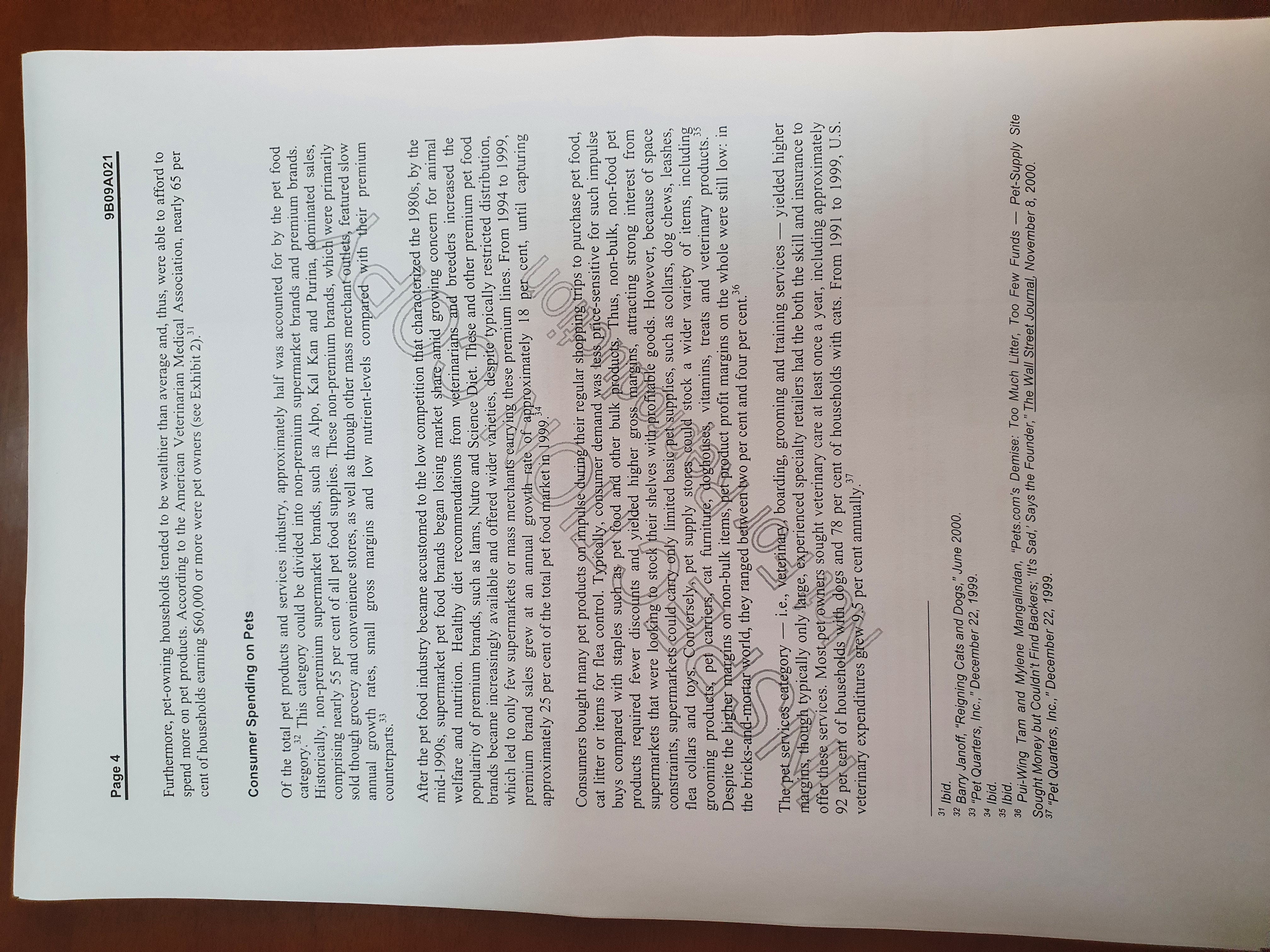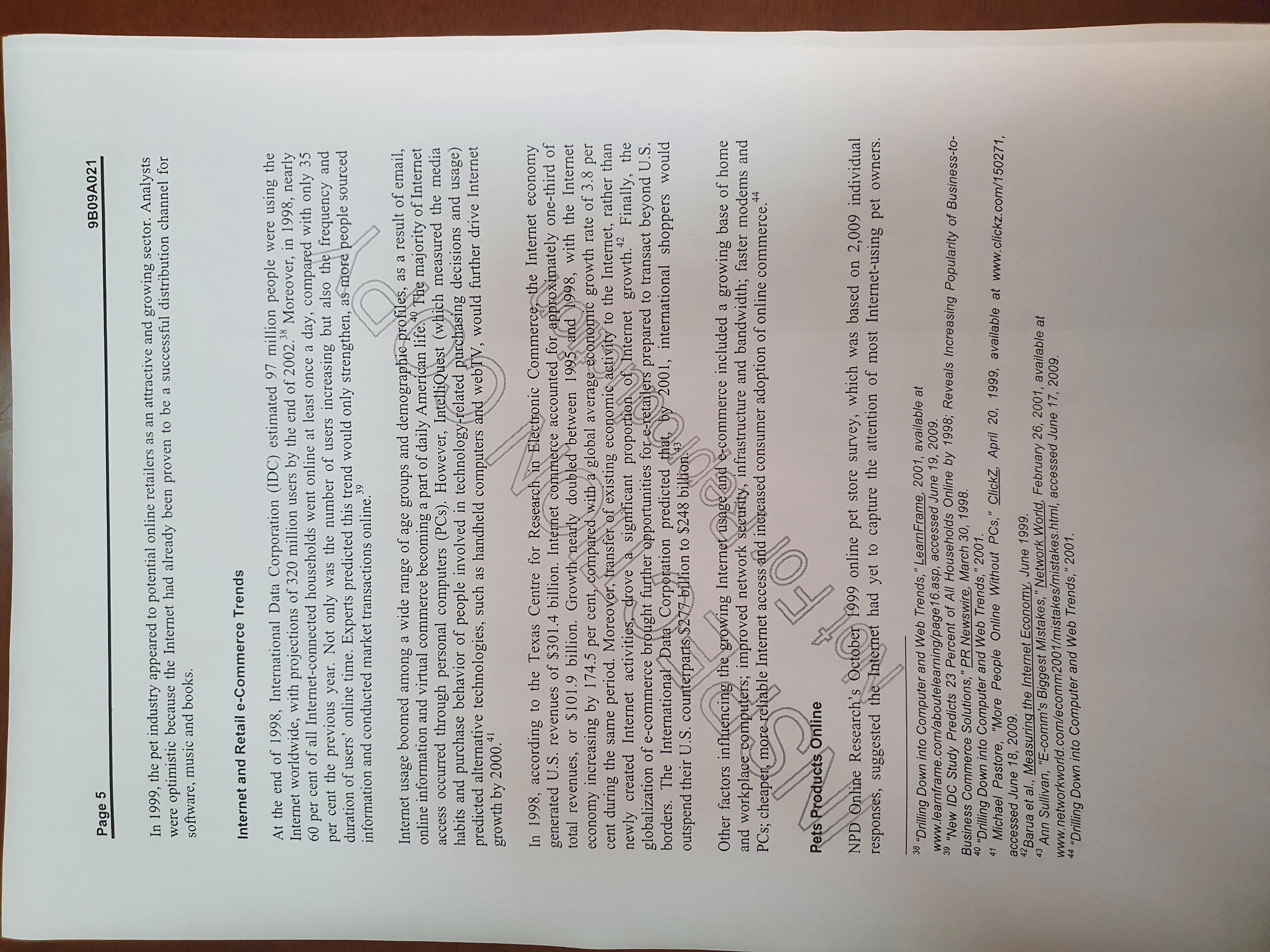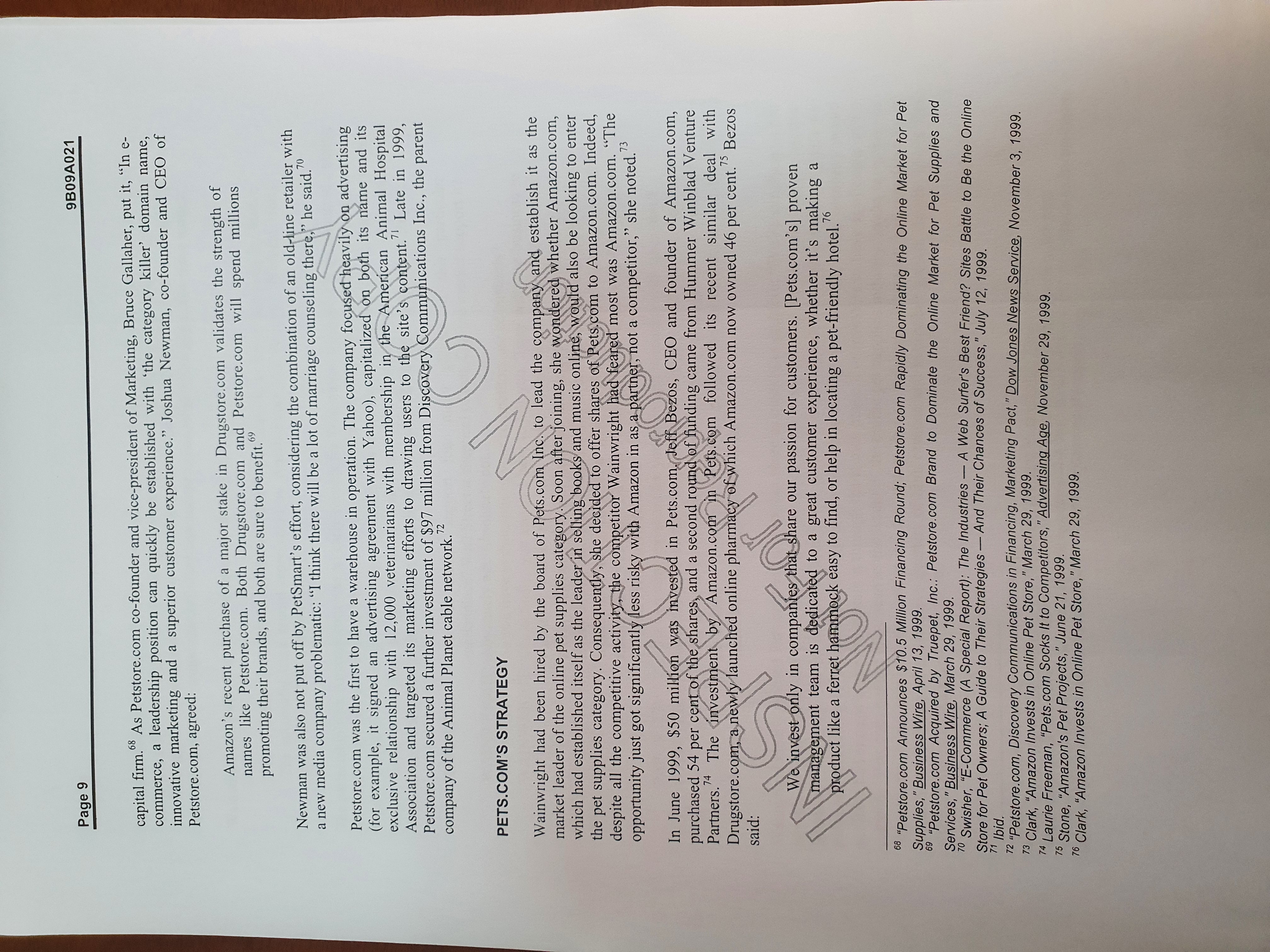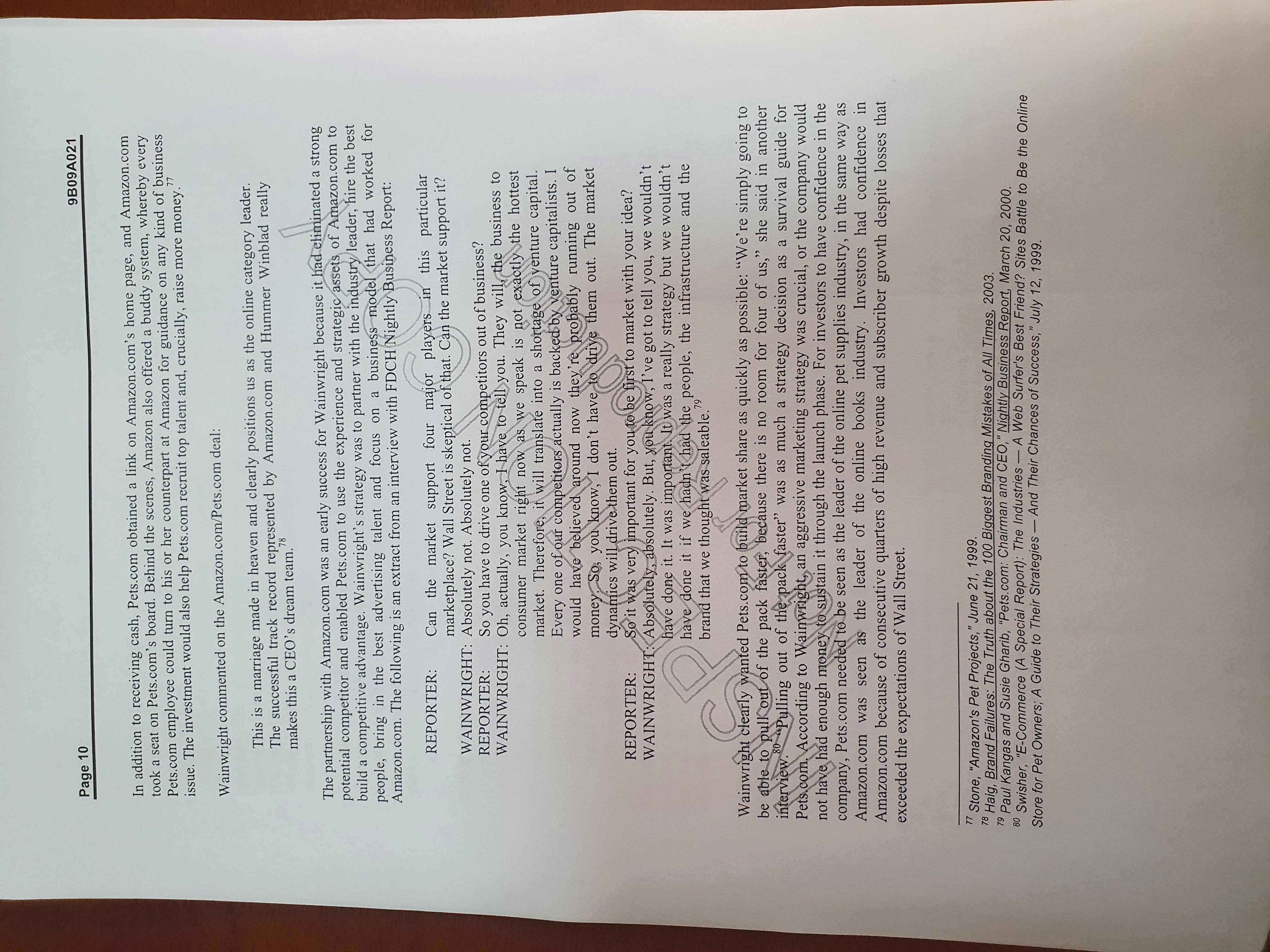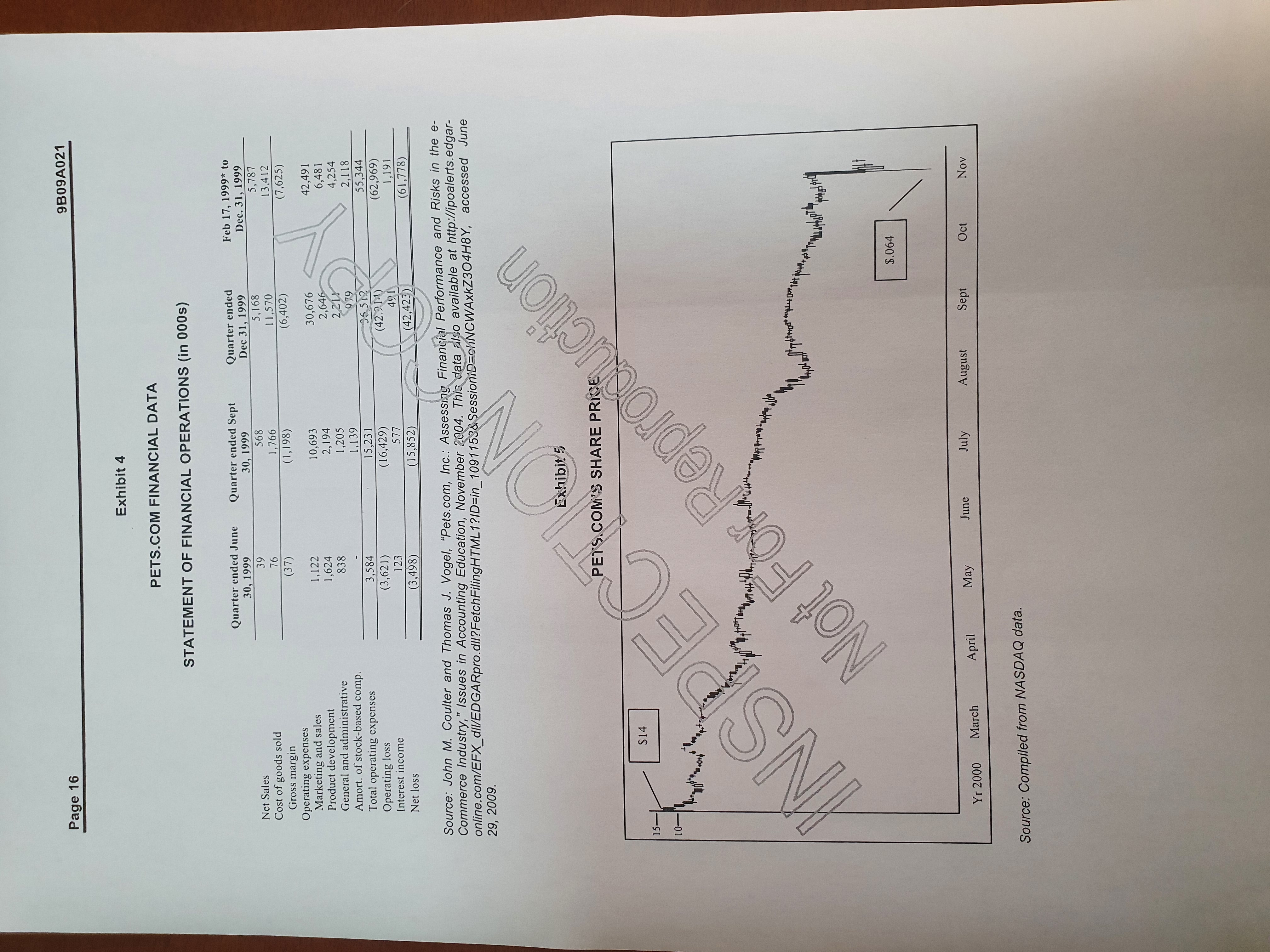Richard Ivey School of Business The University of Western Ontario IVEY 9B09A021 PETS.COM INC.: RISE AND DECLINE OF A PET SUPPLY RETAILER Dr. Omar Merlo wrote this case solely to provide material for class discussion. The author does not intend to illustrate either effective or ineffective handling of a managerial situation. The author may have disguised certain names and other identifying information to protect confidentiality. Ivey Management Services prohibits any form of reproduction, storage or transmittal without its written permission. Reproduction of this material is not covered under authorization by any reproduction rights organization. To order copies or request permission to reproduce materials, contact Ivey Publishing, Ivey Management Services, clo Richard Ivey School of Business, The University of Western Ontario, London, Ontario, Canada, NGA 3K7; phone (519) 661-3208; fax (519) 661-3882; e-mail cases@ivey.uwo.ca. Copyright @ 2009, Ivey Management Services Version: (A) 2009-09-15 THE BIRTH OF PETS.COM In 1994, Pasadena-based entrepreneur Greg Mclemore registered the Pets.com name. Although Mclemore's commercial intentions for the Pets. com address were not clear from the start, they became apparent in 1998, when he set up an online pet shop with colleague Eva Woodsmall and relocated to San Francisco shortly afterward." In February 1999, Pets.com, Inc. was incorporated as an online retailer of pet products, and the Pets.com website-was also launched. Greg Mclemore, aged 31, was best known for his prior start-up, Toys.com, which had recently been sold to eToys. Mclemore still owned approximately 750,000 shares of eToys, which had filed for an initial public offering (IPO). By January 1999, the world was on the threshold of a new era in which companies would increasingly interact with customers through the virtual space of the Internet, and businesses would undergo a transformation on the scale of the Industrial Revolution. This was the "information revolution," and it had captured the imagination of investors and entrepreneurs who wanted a piece of the cake. Although the Internet had created the opportunity of a new distribution channel for established companies, it also opened the possibility for new companies to enter into established industries without a huge capital investment in a retail distribution channel Not This case has been written on the basis of published sources only. Consequently, the interpretation and perspectives presented in this case are not necessarily those of Pets. com or any of it employees. Brad Stone, "Amazon's Pet Projects, " Newsweek, June 21, 1999. Note that during this time, people often registered domain names with no intention of using them for business purposes, but simply to sell them to interested parties at a later date. This practice was particularly true for "generic" names, such as Pets.com. See Matt Haig, Brand Failures: The Truth about the 100 Biggest Branding Mistakes of All Times, Kogan Page, London, 2003. *Tim Clark, "Amazon Invests in Online Pet Store, " CNET News, March 29, 1999, available at http:/ews.cnet.com/Amazon- invests-in-online-pet-store/2100-1017_3-223621.html, accessed June 20, 2009. John M. Coulter and Thomas J. Vogel, "Pets.com, Inc.: Assessing Financial Performance and Risks in the e-Commerce ndustry, " Issues in Accounting Education, November 2004. Clark, "Amazon Invests in Online Pet Store, " March 29, 1999. Barua et al., Measuring the Internet Economy, June 1999.Page 2 9B09A021 The company leading the dot-com race was Amazon.com. Despite initial skepticism by some industry observers, the company's stock performance was outstanding: by February 1, 1999, its share price had increased to $58 per share from its IPO offer price of $18 per share in May 1997. Moreover, Amazon.com had successfully defined the business model of the dot-com age. According to an observer: Amazon.com has been a darling of Wall Street, albeit a rather unusual one. In five quarters as a public company, Amazon.com has not come close to posting a profit. But the company that makes it easy to order books and music online has seen its stock soar astoundingly as investors see Amazon.com as a leader in Internet commerce. Amazon.com's growth strategy had become an example for all subsequent companies to follow: when choosing between profits and growth, a start-up should opt for growth because substantial growth in revenue and subscribers ensures investor confidence and portrays market leadership. After the success of Amazon.com, the case for selling pet supplies online mirrored that of online bookstores. If Amazon.com could successfully sell books online within the $12 billion U.S. retail book industry, surely a portion of pet supplies be sold online, given a total domestic industry size almost twice as large.9 Pets.com was an exciting business concept that was guaranteed to be a success. By 2004, Forrester Research had forecast online pet product sales to be more than $4.5 billion, and Pets.com was positioning itself to capture a large part of that market. Pets.com's prospects looked so favorable that even outsiders became fans of the company. 2 In March 1999, Mclemore succeeded in his first-round attempts to secure funding for Pets.com, receiving $2 million from a premier venture capital fund, Hummer Winblad Venture Partners (Hummer Winblad). The Silicon Valley-based Hummer Winblad, which focused exclusively on software and Internet investing, had more than $500 million under management. Hummer Winblad's investments included PowerSoft Corporation and Arbor Software, as well as Internet companies Net Perceptions, AdForce, HomeGrocer and Employease. 14 Pets.com named Julie Wainwright as chief executive officer (CEO), a post she took over in March 1999.15 Her previous job had been CEO of the online video store Reel.com, which Amazon.com had recently surpassed as the Internet's top video outlet for non-adult titles. " When Wainwright was approached to be the top executive for Pets.com, she didn't even read the proposal: I did research instead and found the market for pet products is extremely fragmented. .. . Sales go through multiple stores - mass merchants, independent pet stores, supermarkets. Greg Heberlein, "Amazon. Com Loss Is Less than Forecast: Though Red Ink Grows, Sales Skyrocket, New Accounts Rise," Seattle Times Business Reporter, July 23, 1998. "Pet Quarters, Inc.," SECinfo, December 22, 1999, available at www.secinfo.com/dsvrp.6B38.htm, accessed June 17, 2009. " Matt Haig, Brand Failures: The Truth about the 100 Biggest Branding Mistakes of All Times, Kogan Page, London, 2003. Dana Blankenhorn, "Pet Sites Prove It's a Dog-Eat-Dog World," Interactive Week from ZDWire, August 27, 2000. 2 "Death of a Spokespup," Adweek, New England Edition, December 2000. 3 Stone, "Amazon's Pet Projects, " June 21, 1999. 4 "Pets.com Raises $35 Million Third Round of Funding; Most Recent Round of Funding Raises Online Pet Site's Total Capital to Nearly $100 Million, " Business Wire, November 3, 1999. 15 "Reading List, " BusinessWeek, 2000, available at www.businessweek.com/bschools/books/recommenders/wainwright.htm, accessed June 19, 2009 16 Clark, "Amazon Invests in Online Pet Store, " March 29, 1999.Page 3 9B09A021 There isn't one monopolistic figure out there that owns the pet world. . . . I knew it was an opportunity to aggregate products." Wainwright's team consisted of a handful of well-regarded, experienced managers, including a former Procter & Gamble marketing executive, John Hommeyer, who was Pets.com's new vice-president of marketing. THE PET INDUSTRY In 1998, the pet industry was large and growing, consisting of a US$53-billion-a-year global marketplace. " Americans spent nearly $23 billion on their pets annually, according to the Pet Industry Joint Advisory Council, and this number was growing at a rate of $1 billion per year. To put this industry in context, each year Americans spent approximately $21 billion on toys, $13 billion on music recordings and $12 billion on retail books."Some experts predicted that, by 2001, the pet product and services industry would total more than $28 billion.23 Pet Ownership in the United States C Pets were an integral part of American family life, evidenced by the 60 per cent of all U.S. households that owned a pet * and the 40 per cent of all households that owned more than one pet. In particular, dogs and cats drove pet industry sales. As of 1996, Americans reportedly owned 53 million dogs and 59 million cats, with four million more households owning dogs than cats."Pet ownership break-down in 1999 is set out in Exhibit 1.28 Americans simply loved to spend money spoiling their pets. According to a 1999 American Animal Hospital Association survey, 30 per cent of pet owners admitted to cooking special meals for their pets, 25 per cent of pet owners bought their pets gifts and five per cent gave their pets greeting cards. Favorable demographic trends indicated continued growth of the already recession-resistant industry of pet products and services. Families with children between the ages of five and 15 were most likely to own pets. Meanwhile, projections suggested the number of families with children younger than 18 years of age would grow steadily over the next several years. 30 FOR 17 Connie Guglielmo, "Category Killer: Pets.com," Interactive Week from ZDWire, May, 31 1999. 18 Ibid . 19 Barry Janoff, "Reigning Cats and Dogs," Progressive Grocer, June 2000. 20"Amazon.com Announces Investment in Pets.com, " PR Newswire, March 29, 1999. 21 Pet Products Manufacturers Association (APPMA), Greenwich, CT. 22 "Pet Quarters, Inc., " December 22, 1999. 23 Ibid . 24 Joanna Sabatini, "Best of Breed," Adweek, Eastern Edition, November 22, 1999, p. 56. 25 John Fetto and Jennifer Lach, "Pets Can Drive, " American Demographics, March 2000, p. 10. 26 "Pet Quarters, Inc., " December 22, 1999. "U.S. Pet Ownership & Demographics Sourcebook," Center for Information Management, American Veterinary Medical Association, Schaumburg, IL, 1997. 28 "Pet Quarters, Inc., " December 22, 1999. 29 John Fetto and Jennifer Lach, "Pets Can Drive," American Demographics, March 2000, p. 10. 30"Pet Quarters, Inc., " December 22, 1999.Page 4 9B09A021 Furthermore, pet-owning households tended to be wealthier than average and, thus, were able to afford to spend more on pet products. According to the American Veterinarian Medical Association, nearly 65 per cent of households earning $60,000 or more were pet owners (see Exhibit 2)." Consumer Spending on Pets Of the total pet products and services industry, approximately half was accounted for by the pet food category." This category could be divided into non-premium supermarket brands and premium brands. Historically, non-premium supermarket brands, such as Alpo, Kal Kan and Purina, dominated sales, comprising nearly 55 per cent of all pet food supplies. These non-premium brands, which were primarily sold though grocery and convenience stores, as well as through other mass merchant outlets, featured slow annual growth rates, small gross margins and low nutrient-levels compared with their premium counterparts. 35 After the pet food industry became accustomed to the low competition that characterized the 1980s, by the mid-1990s, supermarket pet food brands began losing market share amid growing concern for animal welfare and nutrition. Healthy diet recommendations from veterinarians and breeders increased the popularity of premium brands, such as Iams, Nutro and Science Diet. These and other premium pet food brands became increasingly available and offered wider varieties, despite typically restricted distribution, which led to only few supermarkets or mass merchants carrying these premium lines. From 1994 to 1999, premium brand sales grew at an annual growth rate of approximately 18 per cent, until capturing approximately 25 per cent of the total pet food market in 1999. Consumers bought many pet products on impulse during their regular shopping trips to purchase pet food, cat litter or items for flea control. Typically, consumer demand was less price-sensitive for such impulse buys compared with staples such as pet food and other bulk products. Thus, non-bulk, non-food pet products required fewer discounts and yielded higher gross margins, attracting strong interest from supermarkets that were looking to stock their shelves with profitable goods. However, because of space constraints, supermarkets could carry only limited basic pet supplies, such as collars, dog chews, leashes, flea collars and toys. Conversely, pet supply stores, could stock a wider variety of items, including grooming products, pet carriers, cat furniture, doghouses, vitamins, treats and veterinary products." Despite the higher margins on non-bulk items, pet product profit margins on the whole were still low: in the bricks-and-mortar world, they ranged between two per cent and four per cent. The pet services category - i.e., Veterinary, boarding, grooming and training services - yielded higher margins, though typically only large, experienced specialty retailers had the both the skill and insurance to offer these services. Most pet owners sought veterinary care at least once a year, including approximately 92 per cent of households with dogs and 78 per cent of households with cats. From 1991 to 1999, U.S. veterinary expenditures grew 9.5 per cent annually. 37 31 Ibid . 32 Barry Janoff, "Reigning Cats and Dogs," June 2000. 33 "Pet Quarters, Inc., " December 22, 1999. 34 Ibid. 35 Ibid. 3 Pui-Wing Tam and Mylene Mangalindan, "Pets.com's Demise: Too Much Litter, Too Few Funds - Pet-Supply Site Sought Money but Couldn't Find Backers; 'It's Sad,' Says the Founder, " The Wall Street Journal, November 8, 2000. 7 "Pet Quarters, Inc., " December 22, 1999.Page 5 9B09A021 In 1999, the pet industry appeared to potential online retailers as an attractive and growing sector. Analysts were optimistic because the Internet had already been proven to be a successful distribution channel for software, music and books. Internet and Retail e-Commerce Trends At the end of 1998, International Data Corporation (IDC) estimated 97 million people were using the Internet worldwide, with projections of 320 million users by the end of 2002." Moreover, in 1998, nearly 60 per cent of all Internet-connected households went online at least once a day, compared with only 35 per cent the previous year. Not only was the number of users increasing but also the frequency and duration of users' online time. Experts predicted this trend would only strengthen, as more people sourced information and conducted market transactions online." Internet usage boomed among a wide range of age groups and demographic profiles, as a result of email, online information and virtual commerce becoming a part of daily American life. The majority of Internet access occurred through personal computers (PCs). However, IntelliQuest (which measured the media habits and purchase behavior of people involved in technology-related purchasing decisions and usage) predicted alternative technologies, such as handheld computers and webTV, would further drive Internet growth by 2000.41 In 1998, according to the Texas Centre for Research in Electronic Commerce, the Internet economy generated U.S. revenues of $301.4 billion. Internet commerce accounted for approximately one-third of total revenues, or $101.9 billion. Growth nearly doubled between 1995 and 1998, with the Internet economy increasing by 174.5 per cent, compared with a global average economic growth rate of 3.8 per cent during the same period. Moreover, transfer of existing economic activity to the Internet, rather than newly created Internet activities, drove a significant proportion of Internet growth. " Finally, the globalization of e-commerce brought further opportunities for e-retailers prepared to transact beyond U.S. borders. The International Data Corporation predicted that, by 2001, international shoppers would outspend their U.S. counterparts $277 billion to $248 billion. 43 Other factors influencing the growing Internet usage and e-commerce included a growing base of home and workplace computers; improved network security, infrastructure and bandwidth; faster modems and PCs; cheaper, more reliable Internet access and increased consumer adoption of online commerce. Pets Products Online FO NPD Online Research's October 1999 online pet store survey, which was based on 2,009 individual responses, suggested the Internet had yet to capture the attention of most Internet-using pet owners. 38 "Drilling Down into Computer and Web Trends, " LearnFrame, 2001, available at www.learnframe.com/aboutelearning/page 16.asp, accessed June 19, 2009. "New IDC Study Predicts 23 Percent of All Households Online by 1998; Reveals Increasing Popularity of Business-to- Business Commerce Solutions, " PR Newswire, March 30, 1998. to "Drilling Down into Computer and Web Trends, "2001. # Michael Pastore, "More People Online Without PCs," ClickZ, April 20, 1999, available at www.clickz.com/150271, accessed June 18, 2009. "Barua et al., Measuring the Internet Economy, June 1999. Ann Sullivan, "E-comm's Biggest Mistakes, " Network World, February 26, 2001, available at www.networkworld.com/ecomm2001/mistakes/mistakes.html, accessed June 17, 2009. 44 "Drilling Down into Computer and Web Trends, " 2001.Page 6 9B09A021 However, present online pet store shoppers reported high levels of satisfaction. Of the nearly 30 per cent of Internet users who had purchased from an online pet store, more than half reported being very satisfied with their buying experience, and many intended to shop online again. The survey also revealed that females were the majority of buyers of online pet supplies. Women comprised 68 per cent of all online sales and spent nearly double the online pet supply purchases of men. The study also found that most pet owners discovered online pet stores by browsing the Internet. Toys were the most popular Internet pet store purchase, despite wide-ranging available items. Forty per cent of polled consumers bought toys for their pets online, compared with approximately 30 per cent of consumers who bought food or treats online; 26 per cent who purchased non-food accessories online and 17 per cent who bought health products online. Nearly half of all buyers spent up to $25 during an average visit, whereas 37 per cent spent between $25 and $50.46 According to NPD, convenience was the top reason for making an online pet supplies purchase. Other rationale reflected the time savings, flexible hours and reduced effort of Internet purchasing (see Exhibit 3). However, some experts believed such benefits were limited to a small market and, in the long run, would be outweighed by higher costs and longer waits. For example, Matt Stamski of Gomez Advisors, an e-commerce consultancy, claimed that pet supplies were not a natural e-tail market; and, instead, believed that pet owners were less likely than others to shop online. Thus, one of the key challenges of online pet shops was to convince the public of the superior value of online shopping compared with regular shopping trips. The online competitors needed to be quick to establish a clear identity in the market and to communicate their unique value proposition. 48 THE COMPETITION: READY FOR A CAT FIGHT Action Wainwright acknowledged the attractiveness of the pet industry, which was appealing to a large number of competitors: I've never seen so many companies in a category, and they may all get funded. I don't think there's room for two. It'll be a bloodbath with huge cash outlays and low margins. It's a tough business. 49 In 1999, a Fortune magazine article observed: In the beginning there were books. Then came CDs and videos. Travel vacations, toys, and prescription drugs followed. The latest e-commerce market to hit the Net? Pets. Until now `pet owners haven't had a Website that will answer questions, quell concerns, and sell chewy toys for Fido and Fluffie. Now get ready for the pet portal wars." With at least six major online pet competitors, Silicon Valley venture capitalists studied the largest pet portals to determine the next lucrative "Amazon or eBay of the animal kingdom." 46 Ibid . 45"Online Pet Stores Poised for Success, Reports NPD Online Research, " Business Wire, October 12, 1999. 47 Ibid . 48 Troy Wolverton, "Pets.com Latest High-Profile Dot-com Disaster," CNET News, November 7, 2000, available at http:/ews.cnet.com/2100-1017-248230.html, accessed June 20, 2009. 4 Clark, "Amazon Invests in Online Pet Store, " March 29, 1999. 50 Melanie Warner, "The Latest Fad in Portals: Your Pet, " Fortune, May, 10 1999. 51 Ibid .Page 7 9B09A021 Of the dozens of competitors that were being set up at the same time as Pets.com, or shortly after, the most noteworthy were Petopia.com, PetSmart.com and PetStore.com.Each claimed superior advantages, predicting that other sites were likely to fold first; yet, at various times, all had also talked about merging with competitors. In the meantime, predicting which company would emerge as top dog was nearly impossible. $3 Petopia.com The bricks-and-mortar pet chain Petco, with 465 stores nationwide and 100 international stores, hired banker Morgan Stanley to create its own online strategy. " Petopia.com, a San Francisco-based company, caught Petco's attention because it had just secured $9 million from Technology Crossover, a high-profile venture capital firm that believed in the pet market's online potential." The name Petopia was the brainchild of Catchword, a brand-development firm. Burt Alper, Catchword's co-founder and strategy director, commented on the name: When we evaluated the competitive landscape, it became clear that we needed a name that would stand out from the crowd without distancing the consumer. Petopia, coined from the words "pet" and "utopia," meaning "an ideally perfect place,') communicates a terrific shopping experience for pet owners, in a playful, yet sophisticated way. $6 In 1999, Petco decided to back Petopia.com. Petco's brand name was well known for its quality products and its commitment to animal care. Andrea Reisman, Petopia.com's co-founder and CEO commented: We're changing the way pet owners think about shopping for pet supplies. By extending the "bricks-and-mortar" pet business to the online marketplace, Petopia.com is able to create a place to go, a virtual park of sorts, where owners can research information about their pet's needs, shop for pet food and supplies, and interact in a warm community with other owners who share the same interests." O The Petco portion of the deal involved a strategic partnership in which the two companies could cross- promote each other and leverage both their assets. For example, with Petco as a partner, Petopia.com had access to world-class purchasing and distribution capabilities. 60 A further source of funding for Petopia was found in Groupe Arnault, a new venture capital arm of the European consumer products giant LVMH Moet Hennessey Louis Vuitton. The deal opened the door to potential international expansion at a later stage. 52 Joelle Tessler, "San Francisco-Based Online Pet Store Will Close," Knight Ridder Tribune Business News, November 8, 2000. Kara Swisher, "E-Commerce (A Special Report): The Industries - A Web Surfer's Best Friend? Sites Battle to Be the Online Store for Pet Owners; A Guide to Their Strategies - and Their Chances of Success," The Wall Street Journal, July 12, 1999. $4 Stone, "Amazon's Pet Projects, " June 21, 1999. $5 Guglielmo, "Category Killer: Pets.com, " May, 31 1999. "Catchword Names Petopia.com, New Online Pet Supply and Service Firm, " Business Wire, May 26, 1999. "PETCO Announces Strategic Partnership with Petopia. com to Launch the Premier Online Pet Commerce Site, " Business Wire, July 13, 1999 "Petopia.com Announces $9 Million Equity Investment from Technology Crossover Ventures; Company Changes Name From paw.net to Petopia.com," PR Newswire, May 10, 1999 Andrea Orr, "Online Pet Store Raises $66 Million in Funding, " Reuters News, July 14, 1999. "Petopia.com Unleashes the Internet Pet Paradise; The Virtual Animal Park Blending Commerce, Content and Community with Individual Customization, " Business Wire, August 2, 1999.Page 8 9B09A021 In total, Petopia.com had managed to secure $66 million in investment, one of the largest sums ever for an Internet start-up; however, Petopia joined Pets.com in an already crowded market. When asked how Petopia differentiated itself from the competition, chair and co-founder Andrea Reisman responded with an answer that foreshadowed the spending spree the industry was just about to witness: "We're the best funded."62 PetSmart.com One of Petco's main bricks-and-mortar competitors, PetSmart, also wanted a piece of the action. PetSmart launched its online presence, PetSmart.com, in 1999. PetSmart, a Phoenix-based discounter of pet products, with nearly 500 stores nationwide and 100 international stores, generated $2 billion a year in sales. In 1999, PetSmart entered into a joint venture with e-commerce entrepreneur Bill Gross of Idealab. 63 A July 1999 article in the Wall Street Journal reported: "PetSmart.com presents to Pets.com the same kind of challenge that Amazon.com has been fighting off from Barnesandnoble.com."64 According to PetSmart officials, the two partners invested $5 million each in the PetSmart.com venture based in Pasadena, California. PetSmart CEO Phil Francis said PetSmart's strong brand name, marketing clout, close vendor relationships and efficient catalog order fulfillment systems would greatly benefit the website. Referring to bricks-and-mortar stores that had seen intense competition from Web competitors, Francis commented: Usually, the story is how the online retailer attacks the big box. Now it's big box and e- commerce retailers combining . . . this is a template for the future. Tom McGovern, CEO of the joint venture, thought a fast-moving traditional retailer with a substantial Internet presence could dominate the nascent online pet market. According to McGovern, PetSmart.com's advantages included a strong back-end warehouse and delivery systems, purchasing power, vendor relationships, national advertising and brand name. Many analysts agreed that PetSmart was ahead of the pack because it had already developed brand recognition. Indeed, McGovern did not expect to lose to Pets.com when the new website went online in 1999 They are not the Goliath in this situation. I don't discount any of the [competitors], but each one is going to have to struggle through the basic blocking and tackling that we have done already. 67 Petstore.com lot For Pets.com's third main competitor was another California-based start-up, Petstore.com. This company's initial round of funding yielded $10.5 million, mainly supplied by Battery Ventures, a national venture 61 Orr, "Online Pet Store Raises $66 million in Funding," July 14, 1999. 82 Ibid. "Discounter PetSmart, Entrepreneur to Merge Pet-Products Web Sites, " Dow Jones Business News, May 13, 1999. * Swisher, "E-Commerce (A Special Report): The Industries - A Web Surfer's Best Friend? Sites Battle to Be the Online Store for Pet Owners; A Guide to Their Strategies - and Their Chances of Success," July 12, 1999. Kara Swisher, "Discounter PetSmart Scampers Online in Venture with E-Commerce Incubator," The Wall Street Journal May 13, 1999. Swisher, "E-Commerce (A Special Report): The Industries - A Web Surfer's Best Friend? Sites Battle to Be the Online Store for Pet Owners; A Guide to Their Strategies - and Their Chances of Success, " July 12, 1999. 67 Ibid.Page 9 9B09A021 capital firm. As Petstore.com co-founder and vice-president of Marketing, Bruce Gallaher, put it, "In e- commerce, a leadership position can quickly be established with 'the category killer' domain name, innovative marketing and a superior customer experience." Joshua Newman, co-founder and CEO of Petstore.com, agreed: Amazon's recent purchase of a major stake in Drugstore.com validates the strength of names like Petstore.com. Both Drugstore.com and Petstore.com will spend millions promoting their brands, and both are sure to benefit." Newman was also not put off by PetSmart's effort, considering the combination of an old-line retailer with a new media company problematic: "I think there will be a lot of marriage counseling there," he said." Petstore.com was the first to have a warehouse in operation. The company focused heavily on advertising (for example, it signed an advertising agreement with Yahoo), capitalized on both its name and its exclusive relationship with 12,000 veterinarians with membership in the American Animal Hospital Association and targeted its marketing efforts to drawing users to the site's content. "Late in 1999, Petstore.com secured a further investment of $97 million from Discovery Communications Inc., the parent company of the Animal Planet cable network. 72 PETS.COM'S STRATEGY Wainwright had been hired by the board of Pets.com Inc. to lead the company and establish it as the market leader of the online pet supplies category. Soon after joining, she wondered whether Amazon.com, which had established itself as the leader in selling books and music online, would also be looking to enter the pet supplies category. Consequently, she decided to offer shares of Pets.com to Amazon.com. Indeed, despite all the competitive activity, the competitor Wainwright had feared most was Amazon.com. "The opportunity just got significantly less risky with Amazon in as a partner, not a competitor," she noted." In June 1999, $50 million was invested in Pets.com. Jeff Bezos, CEO and founder of Amazon.com, purchased 54 per cent of the shares, and a second round of funding came from Hummer Winblad Venture Partners. ' The



